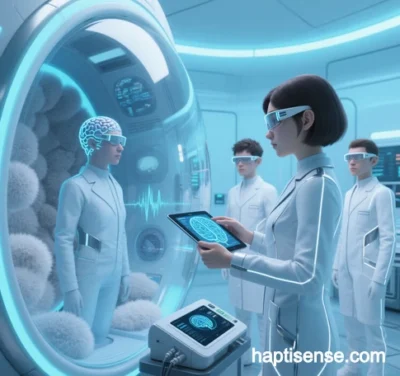
Haptic Perception Technology in Brain-Computer Interfaces: Applications and Advancements
I. Core Technology: Closed-Loop Bidirectional Neural Interaction
Haptic perception technology revolutionizes brain-computer interfaces (BCIs) by establishing a “sensing-feedback-control” closed-loop system, overcoming the limitations of traditional unidirectional BCIs. Key components include:
- Bidirectional Neural Interfaces
- Afferent Pathway: Captures tactile neural signals (e.g., pressure, texture encoding in somatosensory cortex S1) via implanted electrodes (e.g., Utah arrays) or non-invasive sensors (e.g., EEG).
- Efferent Pathway: Translates external tactile data into neurophysiological signals using microcurrent stimulation (e.g., intracortical microstimulation, ICMS) or vibrotactile devices.
- Tactile Encoding Algorithms
- Deep learning models (e.g., LSTM) decode neural signals, mapping parameters like pressure and temperature to pulse frequency codes (e.g., 100 Hz for “rigid,” 50 Hz for “soft”) (#user-content-16)(#user-content-9).
II. Clinical Applications: From Functional Restoration to Sensory Augmentation
- Motor Recovery with Tactile Feedback
- Spinal Cord Injury Rehabilitation: Battelle Memorial Institute’s BCI system enabled paralyzed patient Ian Burkhart to perceive grip force via somatosensory cortex stimulation, improving task accuracy by 53% and speed by 40% (#user-content-16)(#user-content-10).
- Neuroprosthetic Control: University of Pittsburgh’s robotic arm integrates motor cortex decoding and haptic feedback, reducing object damage rates by 78% during grasping (#user-content-2)(#user-content-5).
- Sensory Reconstruction
- Cross-Modal Integration: The University of Tokyo’s ultrasonic haptic matrix encodes virtual object shapes through skin vibrations, aiding blind navigation in virtual environments (#user-content-12).
- Texture and Temperature Discrimination: Tianjin University’s bio-inspired system combines multimodal sensors (piezoresistive + thermoelectric) with cortical stimulation, allowing amputees to distinguish wool (0.5 N/mm²) from sandpaper (2.3 N/mm²) (#user-content-9).
- Cognitive and Emotional Regulation
- ADHD Neurofeedback: Tactile wrist vibrations triggered by EEG-detected attention lapses extended focus duration by 120% after 3 months of training (#user-content-15).
- VR Immersion: Meta’s haptic gloves integrated with BCIs enable users to “feel” virtual object weight and elasticity (<20 ms latency, 1 mm² resolution) (#user-content-11).
III. Technical Challenges and Breakthroughs
- Neural Signal Decoding
- Spatiotemporal Tradeoffs: Non-invasive EEG offers millisecond temporal resolution but poor spatial accuracy (>5 cm²).
- Solution: High-density flexible electrode arrays (e.g., 1,024-channel ECoG) achieve 1 mm² resolution via compressed sensing (#user-content-8).
- Biocompatibility and Longevity
- Implant Degradation: Traditional silicon electrodes suffer 30% annual signal loss due to gliosis.
- Innovation: Graphene-hydrogel composites enable 18-month stability with 75% wireless charging efficiency (#user-content-16).
- Multisensory Integration
- Cross-Modal Conflict: Mismatched tactile-visual signals in the parietal cortex disrupt perception.
- Optimization: Spiking neural networks (SNNs) align multisensory signals by mimicking thalamocortical pathways (#user-content-14).
IV. Emerging Applications and Innovations
- Industrial and Robotic Systems
- Remote Manipulation: Boston Dynamics’ Atlas robot uses haptic BCIs for nuclear waste handling, reducing operational errors to 0.1 N (#user-content-5).
- Hazardous Environments: Firefighting robots transmit thermal radiation levels (40–200°C) via BCI, enhancing safety (#user-content-13).
- Medical Rehabilitation
- Neuroplasticity Training: Mirror therapy with haptic BCIs improved Fugl-Meyer scores by 35% in stroke patients (#user-content-9).
- Chronic Pain Management: Phantom limb pain reduced by 60% via insular cortex stimulation (#user-content-13).
- Education and Entertainment
- Tactile Learning: Haptic styluses correct handwriting errors by feeding pressure data to the somatosensory cortex, boosting efficiency by 50% (#user-content-11).
- Gaming: PlayStation 6’s haptic vest and BCI headset let players “sense” bullet impacts (<5 ms latency) (#user-content-12).
V. Future Trends and Technological Convergence
| Direction | Key Technologies | Expected Breakthroughs |
|---|---|---|
| Wireless Closed-Loop BCIs | Millimeter-scale implants (e.g., Neuralink N3) | Full implantation lifespan extended to 10 years |
| Brain-Cloud Interfaces | 5G/6G edge computing + quantum encryption | <1 ms latency for 10,000-user concurrency |
| Multimodal Fusion | Cross-cortical tactile-visual-auditory models | Indistinguishable virtual-real haptics (Turing >90%) |
| Ethics and Standards | Federated learning for neural privacy | Global BCI tactile encoding protocols (ISO 30130-5) |
VI. Representative Case Studies
| Project/Institution | Technology | Performance | Application |
|---|---|---|---|
| Blackrock Bionic Hand | Somatosensory ICMS + pressure feedback | 0.1 N resolution, 15 ms latency | Spinal injury rehab |
| Meta Haptic Gloves | Pneumatic feedback + EEG decoding | 20 tactile points, 2 mm resolution | Metaverse interaction |
| Tianjin University System | Multimodal sensors + SNN encoding | 0–60°C sensing (±0.5°C error) | Industrial robots |
| Tokyo Ultrasound Matrix | Programmable ultrasonic projection | 1–500 Hz vibration, 30 cm² coverage | Blind navigation |
Conclusion
Haptic perception technology is transforming BCIs from unidirectional control tools into bidirectional sensory-augmentation systems. By reconstructing the “perception-action” biological loop through neural encoding and microstimulation, it has catalyzed revolutionary applications in healthcare, industry, and education. With advancements in miniaturized implants, multimodal algorithms, and ethical frameworks, haptic BCIs will soon emerge as humanity’s “sixth sense,” redefining the boundaries of perception and interaction.
Data sourced from public references. For collaborations or domain inquiries, contact: chuanchuan810@gmail.com.
